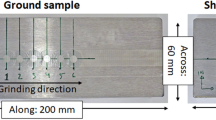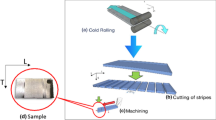Abstract
The formation of surface relief after the grinding of a niobium alloy by corundum and silicon-carbide wheels with ceramic binder is considered. A scanning dual-beam electron microscope is used to study the ground surface.




Similar content being viewed by others
REFERENCES
Dritsa, M.E., Svoistva elementov: Spravochnik (Properties of Elements: Handbook), Moscow: Metallurgiya, 1985.
Chelnokov, V.S., Blinkov, I.V., and Anikin, A.O., Tugoplavkie metally: primenenie i svoistva tugoplavkikh metallov (Refractory Metals: Applications and Properties of Refractory Metals), Moscow: Mosk. Inst. Stali Splavov, 2011. ISBN 978-5-87623-392-9
Nosenko, V.A., The effect of contact interaction on wear of abrasive tools during grinding, Probl. Mashinostr. Nadezhnosti Mash., 2005, no. 1, pp. 73–77.
Spravochnik tekhnologa (Handbook of Technologist), Suslov, A.G., Ed., Moscow: Innovatsionnoe Mashinostroenie, 2019. ISBN 978-5-907104-23-5
Botyashin, V.N., Koziner, Yu.D., Orlov, V.I., and Kravtsov, D.A., Improving the efficiency of the grinding of refractory niobium alloys, Nauchno-Tekh. Vestn. Povolzh., 2018, no. 4, pp. 30–32. https://doi.org/10.24153/2079-5920-2018-8-4-30-32
Volkov, A.I., Stroenie atomov i periodicheskii zakon: Uchebnoe posobie (The Structure of Atoms and the Periodic Law: Manual), Moscow: Novoe Znanie, 2006.
Nosenko, V.A., Intensity of contact interaction of d-transitional metals with silicon carbide during grinding, Probl. Mashinostr. Nadezhnosti Mash., 2002, no. 5, pp. 78–84.
Nosenko, V.A., Fetisov, A.V., and Kuznesov, S.P., Transfer of cubic boron nitride grinding wheel wear products to the nickel alloy surface, MATEC Web Conf., 2020, vol. 329, art. ID 03050.
Nosenko, S.V., Nosenko, V.A., and Kremenetskii, L.L., The condition of machined surface of titanium alloy in dry grinding, Procedia Eng., 2017, vol. 206, pp. 115–120.
Nosenko, S.V., Nosenko, V.A., Krutikova, A.A., and Kremenetskii, L.L., Surface-layer composition of titanium alloy after dry grinding by a silicon-carbide wheel, Russ. Eng. Res., 2015, vol. 35, no. 7, pp. 554–557.
Miao, Q., Ding, W., Gu, Y., and Xu, J., Comparative investigation on wear behavior of brown alumina and microcrystalline alumina abrasive wheels during creep feed grinding of different nickel-based superalloys, Wear, 2019, vols. 426–427, pp. 1624–1634.
de Mello, A.V., de Silva, R.B., Machado, Á.D., Gelamo, R.V., et al., Surface grinding of Ti–6Al–4V alloy with SiC abrasive wheel at various cutting conditions, Procedia Manuf., 2017, vol. 10, pp. 590–600.
Lv, X., Duan, F., Fu, X., and Gan, L., Deep active learning for surface defect detection, Sensors, 2020, vol. 20, no. 6, p. 1650.
Boud, F., Carpenter, C., Folkes, J., and Shipway, P., Abrasive water jet cutting of a titanium alloy: the influence of abrasive morphology and mechanical properties on workpiece grit embedment and cut quality, J. Mater. Process. Technol., 2010, vol. 210, pp. 2197–2205.
Tressia, G., Penagos, J.J., and Sinatora, A., Effect of abrasive particle size on slurry abrasion resistance of austenitic and martensitic steels, Wear, 2017, vols. 376–377, pp. 63–69.
Nosenko, S.V., Nosenko, V.A., and Kremenetskii, L.L., Influence of dressing of the wheel on the surface quality of titanium alloy in deep grinding, Russ. Eng. Res., 2014, vol. 34, no. 10, pp. 632–636.
Nosenko, V.A., Fetisov, A.V., and Kuznetsov, S.P., Morphology and chemical composition of the titanium alloy surface at the initial stage of grinding with a cubic boron nitride wheel, Obrab. Met.: Tekhnol., Oborud., Instrum., 2020, vol. 22, no. 2, pp. 30–40.
Wang, R.X., Zhou, K., Yang, J., Ding, H., et al., Effects of abrasive material and hardness of grinding wheel on rail grinding behaviors, Wear, 2020, vols. 454–455, art. ID 203332.
Hood, R., Cooper, P., Aspinwall, D.K., and Soo, S.L., Creep feed grinding of γ-TiAl using single layer electroplated diamond superabrasive wheels, CIRP J. Manuf. Sci. Technol., 2015, vol. 11, pp. 36–44.
Liao, Z., Abdelhafeez, A., Li, H., Yang, Y., et al., State-of-the-art of surface integrity in machining of metal matrix composites, Int. J. Mach. Tools Manuf., 2019, vol. 143, pp. 63–91.
Lv, X., Duan, F., Fu, X., and Gan, L., Deep active learning for surface defect detection, Sensors, 2020, vol. 20, no. 6, p. 1650.
Nosenko, V.A., Belukhin, R.A., Fetisov, A.V., and Morozova, L.K., Testing complex based on the CHEVALIER precision profile-grinding CNS machine of SMART-V1224 III model, Izv. Volgograd. Gos. Tekh. Univ., 2016, no. 5 (184), pp. 35–39.
Garshin, A.P. and Fedotova, S.M., Abrazivnye materialy i instrumenty. Tekhnologiya proizvodstva (Abrasive Materials and Tools: Production Technology), St. Petersburg: S-Peterb. Gos. Politekhn. Univ., 2008. ISBN 978-5-7422-1853-1
Author information
Authors and Affiliations
Corresponding author
Additional information
Translated by B. Gilbert
About this article
Cite this article
Nosenko, V.A., Fetisov, A.V., Kuznetsov, S.P. et al. Surface Impregnation of Niobium Alloy in Grinding by Corundum and Silicon-Carbide Wheels. Russ. Engin. Res. 42, 145–150 (2022). https://doi.org/10.3103/S1068798X22020186
Received:
Revised:
Accepted:
Published:
Issue Date:
DOI: https://doi.org/10.3103/S1068798X22020186




